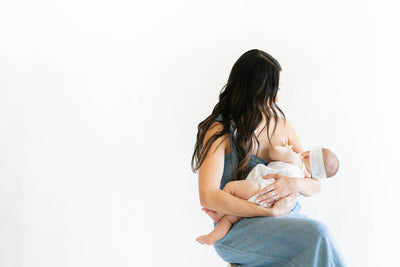In our past blog post, Reasons Why Moms Stop Breastfeeding Early, we found that 83.2 percent of mothers start out breastfeeding, however, many stop earlier than recommended. You know your baby and your body best, so if you believe discontinuing breastfeeding is the best choice for your family, then we fully support you. However, if one of the main reasons you want to stop breastfeeding is because of breast pain, we have a few underlying explanations for why you’re experiencing breastfeeding pain and remedies that could help you out before saying ta-ta to your chi-chis
Why Does Breastfeeding Hurt?
Engorgement
If you’re just about to start breastfeeding or are in the very beginning stages, we’re not going to sugarcoat it: breastfeeding ain’t no walk in the park, honey. When you’re just starting out, it can hurt, it can be difficult, and you may find yourself discouraged or uncomfortable more often than not. But like all things, with practice, everything gets easier! You may be experiencing breast pain due to engorgement of your breasts. As your body adapts to your new breastfeeding lifestyle, you will be producing milk at a fairly quick speed. It’s normal for your breasts to feel full, firm, and tender as they continue to expand in order to compensate for your breast milk.
To relieve breast pain from engorgement:
|

Improper Latching
Latching is the term used for when babies attach themselves to the nipple and drink from the breast. For 30 to 60 seconds after your baby initially latches onto your breast, you may feel a slight pain, however the pain should subside as your baby continues to feed within the session. If the pain does not decrease, it may be because your baby isn’t latched on correctly.
To relieve pain from improper latching:
|
Painful Milk Let-down
Let-down, or the milk ejaculation reflex, is when the nerves in your breasts send signals to your body to release milk. According to some ultrasound studies, mothers may experience pain right before or at the very beginning of a breastfeeding session because of the stretching that occurs when your milk ducts open. This pain typically decreases after the first month of breastfeeding.
To relieve pain from milk let-down:
|
Blocked Ducts
If some of your milk ducts aren’t relieved properly, you may develop blocked milk ducts. A sign of blocked ducts is a small, tender lump in your breast. If you notice a lump, make sure you take measures to relieve it quickly. If the blocked duct is not relieved, it could develop into a more serious infection like mastitis.
To relieve pain from blocked ducts:
|
Mastitis
Breast pain due to inexperience breastfeeding is normal, however, if you are experiencing constant breast pain, it could be due to mastitis. Mastitis is an inflammation of the breast tissue that can involve infection. When a blocked duct isn’t treated, it could develop into inflammation in the breast, otherwise known as mastitis.
What are the first signs of mastitis?
You may have mastitis if in addition to having painful, inflamed breasts that have red patches on the skin and have flu-like symptoms such as a fever, aches, swelling or continual burning sensation in your breast.
To relieve pain from mastitis:
|
It is commonly asked if pumping can help with mastitis. Keeping the breast as empty as possible, whether through feeding or pumping, is recommended. To help with pain and ease of flow, using a warm compress before nursing or pumping can aid in reducing inflammation. If mastitis is left untreated, it can cause a breast abscess or pus in the breast tissue. If the infection worsens, mastitis can be fatal.

Will Breastfeeding Ever Stop Hurting?
In short, the answer *should* be yes. We say “should” because it could take time (especially if you just started nursing) or could require extra treatment. Breast pain from breastfeeding is common, but if it is continuous and you suspect something is wrong, it is always best to consult a doctor or lactation specialist to rule out any infections or serious problems.
For even more information about breastfeeding, brush up on our Breastfeeding Guide For New Moms. Get the 411 on everything from breastfeeding terminology, commonly asked questions about breastfeeding, what type of vitamins moms need postpartum, and what foods can help (and hinder) breast milk production.
SOURCES
Ben-Joseph, Elana. “Breastfeeding FAQs: Pain and Discomfort.” KidsHealth. https://kidshealth.org/en/parents/breastfeed-discomfort.html.
“Breast Pain and Breastfeeding.” NHS. 6 Dec. 2018, https://www.nhs.uk/conditions/pregnancy-and-baby/breast-pain-and-breastfeeding/.
“CDC Releases 2018 Breastfeeding Report Card.” 20 Aug. 2018, https://www.cdc.gov/media/releases/2018/p0820-breastfeeding-report-card.html.
“Mastitis.” Mayo Clinic. 19 July 2018, https://www.mayoclinic.org/diseases-conditions/mastitis/symptoms-causes/syc-20374829.
Murray, Donna. “Breastfeeding and the Let-down Reflex.” Verywell Family. 20 Sept. 2019, https://www.verywellfamily.com/the-let-down-reflex-431588.
“Pain: General.” La Leche League International. https://www.llli.org/breastfeeding-info/pain-general/.
Shipley, Lindsey. “How To Relieve Breast Pain While Breastfeeding.” Lactation Link. 9 March 2017, https://lactationlink.com/blog/how-to-relieve-breast-pain-while-breastfeeding/.
Follow us for more tips and conversations about motherhood and share your experiences with us @lovemajka #lovemajka #fuelingmotherhood





